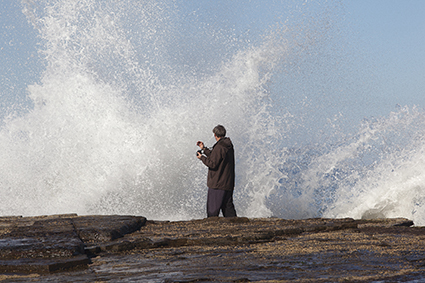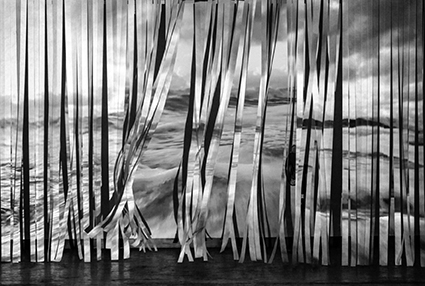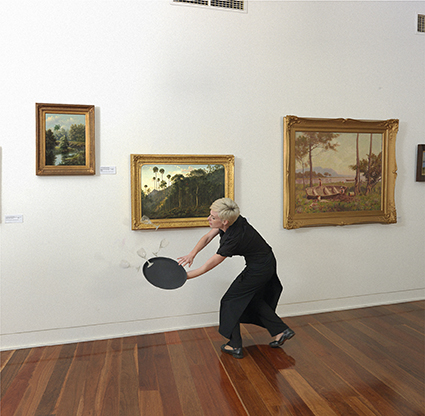Never turn your back on the sea
Laetitia Wilson: Derek Kreckler, Accident And Process

Big Wave Hunting, 2011
Derek Kreckler
Big Wave Hunting, 2011
Derek Kreckler, a name that crackles like fire for an artist who has a fascination with water and often gets wet in the pursuit of his work. Wet Dream is the title of a 1978 work; in a series of slides the artist falls fully suited into the ocean. Here he lies, partially submerged within a moment of abandonment, the water streaming over and around his body. There is an element of chance here, of the accident, the flight of fancy, while at the same time the work is highly constructed and follows a predetermined process leading to its realisation. This is alluded to in its title—by definition the wet dream is about the accident and the following process of clean up. Derek Kreckler: Accident and Process, then, is the fitting title of a solo survey exhibition curated by Hannah Mathews at PICA that commemorates a career spanning five decades.
An oeuvre focused on experimental, conceptual and post-minimalist arts practice across a diversity of media, it is propelled by a perceptive vision engaged in issues across art history, the environment and Indigenous and non-indigenous politics. Kreckler reconstructs historical events, manipulates fact and fiction and pushes the ways images are read and understood. His artwork is pursued with a wry sensibility, an emphasis on performance and fearless propulsion toward ever-new waters.
Antidote (2005) is a six screen video installation that takes as its subject a waterfall shot from different perspectives, at varying scales, with the footage changing between speeds. It is a seemingly banal record of sound and vision at Quinninup Falls in Western Australia and although it demands to be experienced as larger projections than the space at PICA allows for, it nonetheless yields a remarkable sensorial impact. The paradoxically coalescing and dissonant sound and partial imagery build up to affect the viewer more like an abstract noise pattern than a record of the natural world. Then, out of nowhere comes a mysterious whispering voice, like a magical, auditory apparition, pulling the work away from abstraction into somewhere altogether stranger.

Littoral, 2014
Derek Kreckler
Littoral, 2014
In a more recent work, Littoral (2014), the ocean breathes its awesome swell into the gallery space. A black and white projection is doubled by the image falling both on strips of hand-cut Olefin paper and on the background wall. A fan oscillates behind the paper and causes the strips to be flung outwards in sequence. There is something utterly captivating about the combination of the seascape in all its beauty and the very tangible movement and lightness of the paper. The video shifts from a steady image, closer to the shoreline, to a tumbling capture of the shifting horizon, waves at close range, crashing with nauseating proximity. The word ‘littoral’ refers to the intertidal zone of the sea, where the waves break. Other than being a very literal video representation, the shimmering border of paper acts as that point of breakage and movement between the viewer and the projection. The video is never experienced on a surface that is not broken up; the shifting edge of the paper effectively makes manifest the intertidal.
Clearly, Kreckler has devoted time to careful observation and study of the ocean’s behaviour; he has engaged water playfully, immersed himself in the stuff and confronted the threat of being swept away by woolly waters. In Big Wave Hunting (2011) a series of photographs marks a time of being in proximity to the sea. Kreckler himself is pictured with a camera in hand on rocks at a risky precipice of crashing waves. In some images he stands crouched and dwarfed by the foamy spray, in others he is partially or completely obscured; others picture the muggy horizon of the coal industry from the vantage point of Austinmer in New South Wales, where Kreckler lives, as well as ocean and horizon as their sublime selves. The archetypal images of the ocean recall romanticist visions from art history and the entire project stems from a photograph by George Mortimer, also titled Big Wave Hunting (c.1903). In it Mortimer has a rope around his waist theoretically acting as a lifeline as he positions himself on precarious rocks, capturing the surf with his camera ingeniously waterproofed in a wooden box. It is a compelling image of a process that teases the potential for accident, which Kreckler expands into a larger and more layered body of work.

Accident and Process, 2012
Derek Kreckler
Accident and Process, 2012
How a scene is constructed and in turn understood is important to Kreckler. In a series of photographs titled Accident and Process (2012) he creates images of both found and manipulated subject matter: images that are planned and highly controlled yet still about chance and the accident. They are scenes that lead the viewer into speculative narratives. A car is pictured at the moment it has nose-dived into a footpath from a road above; a woman topples wine glasses in a gallery against a backdrop of historical paintings; and a man appears crushed by the fallen limb of a tree. The images look seamless, however digitally pieced together they are; they are artificial but do not look contrived. A seemingly irrelevant figure might be added to or removed from the scene for the sake of making a more interesting, more balanced composition, but otherwise there is nothing that breaks the continuity of subject or picture. They are about the vulnerability of the real, tied to a lineage of pre-digital photographic fakery. In the end it does not matter whether they are real or fake, the medium is simply another means for expressing ideas.
This exhibition even feels like a dot-to-dot between water/ocean themed works with the other works existing like fragments of conversation caught in passing (juicy fragments nonetheless). “Never turn your back on the sea,” said Mortimer, one of Kreckler’s inspirers, and it seems unlikely that this artist’s practice will ever turn away from this enduring subject. Overall, the exhibition offers a remarkable insight into a practice that has come into its own and rigorously and persistently recharged itself into multifarious modes of expression.
–
Derek Kreckler, Accident and Process, PICA, Perth, 29 Aug-18 Oct
2016-17 Tour Dates: 2016: Bunbury Regional Art Gallery, WA, March; Geraldton Regional Art Gallery WA, April; SASA Gallery, University South Australia, July; Horsham Regional Art Gallery, VIC Sept; 2017: Contemporary Art Tasmania & Plimsoll Gallery TAS, Jan; Bathurst Regional Art Gallery NSW, March; Maitland Regional Art Gallery NSW, June; Wollongong City Gallery NSW, Sept 2017
RealTime issue #129 Oct-Nov 2015 pg. 46-47






